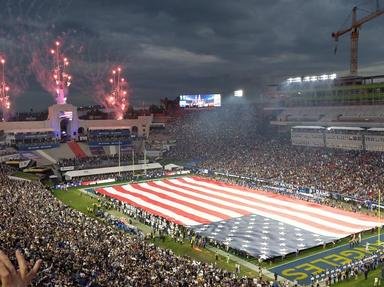Quiz Answer Key and Fun Facts
1. What's the name of the stadium-wide activity that gained worldwide attention during the 1986 World Cup in Mexico and engenders booing of non-participants? It continues to this day.
2. Which musical instrument caused controversy at the 2010 FIFA World Cup in South Africa and is now banned at many sporting venues due to its loud monotone noise?
3. In many sporting events supporters of a team dress in team colors, creating a solid wall of color for their section of the stadium. One of the most well-known in the US is the "Whiteout" to support which American college football team?
4. The Thunder Clap is a rhythmic chant with claps above the head that increases in intensity and speed during the cheer. Although many claim that it originated in Scotland, it was popularized in the 2018 World Cup by supporters of which team?
5. The short break before the start of the fourth quarter of an American football game brings out many ritualistic fan displays. One of the most famous is the earth-shaking "Jump Around" when fans bring the stadium to full roar when jumping the the song of the same name. At which school does this occur?
6. Announcer Myron Cope helped distribute black and gold cloth towels, known as "terrible towels" which are waved in unison, to fans of which NFL team when they won the Super Bowl?
7. The Tomahawk Chop is a sustained series of chopping motions by fans while chanting an Indian "war song", used famously by the Florida State Seminoles college football team. Which baseball franchise also uses the Tomahawk Chop?
8. Many fans attend major league baseball games with gloves in hopes of catching and keeping a ball. In one city fans are expected to throw back onto the field any home run ball they catch that was hit by the opposing team. Which city is this?
9. The Lambeau Leap is one type of interaction between an athlete and the fans. Where does this occur?
10. Many college and NFL stadiums have section set aside for the most rabid of their fans. Which NFL team has a section of fans known as the "Dawg Pound"?
11. Detroit is a rabid hockey town. What old-time tradition did some fans follow to bring luck during the Stanley Cup playoffs?
12. Duke University has had a very successful college basketball team for over 20 years. The student body section is known to be loud, rabid, and hostile to opposing teams. What is the name commonly used for their student section?
13. The vociferous student section at Arizona State University has been able to lower opposing teams free throw percentages by nearly 10 points (e.g. 75% to 65%). What is the name for the method that the students use to achieve these results?
14. The US men's and women's soccer teams have a loud group of fans that follow them to international games with their massive drum. What is this group called?
15. Perhaps the most famous national fan group is the "Barmy Army". Which country's sport do they follow primarily?
Source: Author
SixShutouts66
This quiz was reviewed by FunTrivia editor
gtho4 before going online.
Any errors found in FunTrivia content are routinely corrected through our feedback system.
